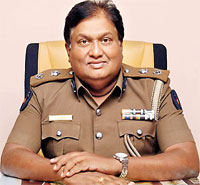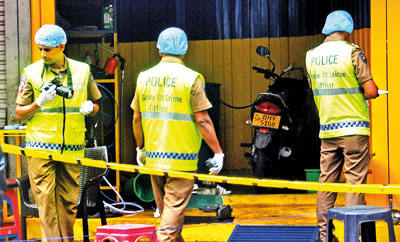News
Weapons and drugs make a dangerous combo, triggering a rise in crimes
View(s):
Priyantha Jayakody
By Chandani Kirinde
Inter-gang rivalries and the fight for control of the illegal narcotics market amidst high demand for heroin in the country have led to an escalation of gun violence, with at least 50 related killings reported in the first half of the year, police and experts studying gang violence said.
“If you analyse the current problem, it shows that the amalgamation of the post-war scenario with the drug business has given rise to a dangerous situation today,” said retired Deputy Inspector General of Police (DIG) Priyantha Jayakody, who served as Director of the Crime and Organised Crime Division and has extensively studied the evolution of gangs in the country.

Dr. Kaushalya Hewawasam
He said drug wars, which started on a small scale in the 1980s when heroin first began entering the country, have escalated to a serious level due to the growing stakes in the illegal drug business, with demand for heroin growing among local addicts.
According to statistics compiled by the National Dangerous Drugs Control Board (NDDCB), in January 2024 alone, about 130 kilograms of heroin were seized by the police. Of the nearly 19,000 arrests made for drug-related offences during that month, 8,269 (44.2%) were for possession of heroin.
The total number of suspects arrested for drug-related offences last year stood at 162,088; of these, 66,142 (40.8%) were heroin-related.
“The heroin that gets smuggled to Sri Lanka originates in the Golden Crescent countries, namely Pakistan, Afghanistan and Iran, and is smuggled into the country by sea in large quantities. Small quantities also come from India,” Mr. Jayakody said.
Heroin and other dangerous drugs were first smuggled into the country via the airport, but as demand grew and airport security tightened, maritime trafficking picked up, and now drug dealers have pickup points in international waters from where the stocks are picked up and smuggled ashore and distributed.
”Advanced communication technology and the use of GPS have made it easy for them to coordinate meeting points in mid-sea,” he said.
According to the Global Organised Crime Index, Sri Lanka is a transit country for heroin, mostly originating from Afghanistan, Pakistan and India, destined for Europe. It notes that heroin is the most widely abused drug in Sri Lanka, making the country a significant destination in the global trade.
Recent open-ocean seizures of heroin indicate a rise in maritime trafficking of the drug, sourced from the Afghanistan-Pakistan region, according to the latest report of the Index.
Dr. Kaushalya Hewawasam of the Department of Criminology and Criminal Justice at Sri Jayewardenepura University said Sri Lanka’s drug gangs lacked the structure of organised criminal groups such as the Mafia or the Yakuza of Japan.

A recent crime scene in Maligawatte. Pic by Nilan Maligaspe
“Such groups have a stable organisation and structure and engage in mass levels of criminal activity, but the mainstay of local gangs involves drugs, street crime and extortion,” she said.
Almost all the youth who are drawn towards these gangs come from lower-income families and consist largely of school dropouts and unemployed youth in their early 20s.
According to criminology theories, crime results from conflicts in society among different social classes and in communities that experience a breakdown in social mores and opportunities, such as in highly populated, lower-income urban communities.
Social learning is also another factor where the young in particular learn from those around them and base their morals and activities on what they see others in their social environment doing, Dr. Hewawasam said.
She added that drug users, when sent to prison, come into contact with hardened criminals, and they often come out and become pawns in the hands of drug dealers and end up joining different gangs.
Another phenomenon police observe is the continuation of criminal activities by a new generation with family ties to some notorious criminal figures from the 1980s and 1990s. In 2019, the son of Ranjith Upali de Silva, alias Soththi Upali, was arrested by police in possession of over 2.5 kg of heroin. Similarly, the son of Mohammed Niyas Naufer, alias Potta Naufer, who was sentenced to death for the murder of High Court Judge Sarath Ambepitiya in 2004, was arrested in India in May this year for alleged links to ISIS. He was arrested by the Sri Lanka Police several years earlier for smuggling gold into the country.
The proliferation of illegal weapons in the country and weapons getting into the wrong hands have led to widespread violence among gang members, with some killings being revenge attacks while others related to disagreements over sharing the ill-gotten money.
The recent killing of former Sri Lanka U-19 cricketer Dhammika Niroshan, who was shot dead outside his home in Ambalangoda on Wednesday, is suspected to be due to a gang rivalry.

Minister Tiran Alles discusses statistics related to crime with IGP Deshabandu Tennekoon while addressing a press conference in Colombo. Pic by Akila Jayawardena
Public Security Minister Tiran Alles told reporters this week that weapons were being smuggled into the country from outside, while there also remained many weapons that got into the wrong hands after the end of the war in 2009.
“We have asked the public to provide tip-offs about illegal weapons and offered cash rewards. Given that there are so many firearms circulating in the country, it’s not surprising that there are crimes involving firearms,” he said.
Retired DIG Jayakody said that along with drugs, weapons were also exchanged at mid-seas by the local drug handlers, and these get smuggled into the country from various points.
“Initially, the smugglers operated from the Chilaw area, where they used fishermen to work for them. Once security around the area began to be tightened, they shifted to the Negombo-Kalpitiya coastal belt, but an increase in naval surveillance in the area due to LTTE activity forced many gangs to move south, with the main hub now centred on Matara,” he added.
DIG Jayakody said that most gangs no longer operated from Colombo but had moved their operations to the suburbs. The Kelani Valley belt, Wellampitiya, Kaduwela, Homagama and Athurugiriya are some areas where gangs remain active.
Gangs operating mainly in crowded urban areas are not entirely a new phenomenon in the country, even though, of late, they have reached new levels of violence.
“In the 1960s, Colombo was becoming a hub for economic activity, and many people were drawn to the city from all parts of the country. With that came shanty towns, mainly in Peliyagoda and Wanathamulla. Many of them found work in the harbour, and some of them took to robbery, extortion and other petty crimes to make extra money. The new shanties became a breeding ground for criminals, and later such activities moved to the provinces as well,” Mr. Jayakody said.
One of the first men to be registered as an Island Reconvicted Criminal (IRC) in the 1960s was a man who came to be known as Cutex Piyadasa, having gotten the name as he robbed several boxes of Cutex (nail polish) from the Colombo port where he was a worker. The first case registered against him was for the “theft of cutex.”
“Such persons were usually local thugs and, in many instances, had support in their own communities. But today the level of gang violence has gone to a new level, with those who give contracts to kill their enemies being bold enough to put their initials on the bullets,” he added.
| The genesis of gangsterism in Sri Lanka Utuwankande Saradiel (1832–1864), Maradankadawela Yakadaya (1921–2011), and Maru Sira (1948–1975) are all sobriquets for some of Sri Lanka’s most notorious criminals of the past, but ones whose life stories have become folklore among locals. These men are remembered not so much for their notoriety (all three were sentenced to death for murder, except for Yakadaya, who was released on a pardon; the other two went to the gallows) but for the romanticised stories linked to them, which have gained mass audiences by way of cinema, songs, etc. While all three came from rural areas, most gangs began to form in Colombo with the migration of people from across the country to the city in the late 1950s and 1960s in search of better lives. With it sprung up several shanty towns, and living in these paltry conditions, some of the new residents of the city took to crime to make ends meet.  Yakadaya: Pic by M.A. Pushpa Kumara With the start of the omnibus companies in the early 1950s that were under the control of a few bus mudalalis, gangsters found patronages from bus company owners who were keen to safeguard their businesses and keep control of their bus routes, for which a bit of thuggery was needed. The nationalisation of the bus service with the establishment of the Ceylon Transport Board (CTB) in 1958 saw the clout of the bus owners wane. Most of the gangsters who became notorious in the 1980s operated from areas such as Gotami Road in Rajagiriya, Dematagoda, Aluth Kade, Modara, Maligawatta, Kollupityiya, and Wellampitiya. Many found political patronage during the second JVP uprising in the 1988–1990 period when they were recruited for the personal security of politicians. They also got access to weapons that were issued by the government to politicians who were being targeted by the JVP. With the proliferation of illicit drugs in the country and the high demand locally for heroin, most gangs have shifted their focus to safeguarding the territories in which they operate. Many of the recent killings, including that of club owner Wasantha Perera and the killing of five people in Beliatta in January this year, are linked to gang rivalries and business partnerships gone wrong. | |
The best way to say that you found the home of your dreams is by finding it on Hitad.lk. We have listings for apartments for sale or rent in Sri Lanka, no matter what locale you're looking for! Whether you live in Colombo, Galle, Kandy, Matara, Jaffna and more - we've got them all!

